
JACKSON CENTER — Sometimes the most wonderful things can be hidden in plain sight.
Case in point: The Gross Memorial Woods, 49-acre nature preserve located about two miles as the crow flies northwest of Jackson Center’s lone traffic light. Sitting on the north side of Botkins Road, just west of the CRX tracks, this particular patch of woods is an interesting anomaly because of its diversity of trees. Gross Memorial is one of the few stands in the state with a mixed-species swamp forest, made even more rare by the fact that it’s a located in the tabletop land of Shelby County, a region not exactly known for its bogs, fens, or wetlands.
Tree stands or “woods” within 150-mile radius of the Gross Memorial Woods are generally dominated by a genus or two of trees, be it oak, maple, beech, evergreen, etcetera. Gross Memorial, thanks to the mini-ecosystems tucked inside its not-quite 50 acres, is quite the opposite. No one type of tree has taken over the place, so burr oaks and basswood trees can be found in the wettest, swampy areas, with every other kind of locust, hickory, beech, oak, and others spread across the rest of the drier sections of the preserve (see sidebar).
Except for a few stubborn hangers-on, most of the deciduous trees have shed their leaves for the winter, which means that the birds of summer – those more often heard than seen – lost their cover of foliage and are now quite easily spotted flitting about. Many of the songbirds and smaller migrants have headed to Guiana for the winter, but there are dozens of species that hang around Ohio all year long. I offer proof of that statement with the pictures accompanying this piece. All were taken over the course of two beautiful days last week, and all from the half-mile boardwalk that leads through the Gross Memorial Woods. The birds shown here are year-round residents, so they will still be there when the first snow flies and beyond.
Many birders keep what is known as a life list (as do I), which keeps tally of the number different species of avians a birder has ID’d live and in person with their own two eyes. With a little patience, the ability to keep quiet for five minutes at a time, and a cheap-o pair of binoculars, any novice could visit Gross Memorial Woods once or twice and get their life list into the double-digits will little effort.
The site was donated by the family of Samuel Gross to the Division of Natural Areas and Preserves via the Ohio Chapter of The Nature Conservancy in 1980, which continues to oversee the preserve.
The boardwalk is well-maintained, about 40 inches wide, level, and solid for the entire half-mile loop, making it nicely wheelchair assessable, but bear in mind that there are no hand-rails or curbings and the boardwalk itself sits several inches off the ground. Given that the planking is slippery when wet, those confined should take a friend in case a wheel should slip off the side, but there is no potential for serious harm to anyone.
Beginners looking for birds should take a field guide. There are any number of good ones, but Roger Tory Peterson’s guide has become known as the Birders’ Bible with excellent reason. It’s easy to use, organized, pocket-sized, complete with maps of the birds’ winter and summer homes, and illustrated by Mr. Peterson’s exquisite drawings (it’s available online for less that $20). You can always borrow one from the local or school library, both of which should have a number of excellent guides for those just starting out.
First-timers with a field guide and some binos should keep an eye out for three particular birds that should be easy to spot at Gross Memorial Woods on any given day.
– The white-breasted nut hatch is indeed wears a white shirt, but makes it prom-ready with a deep blue topcoat, striped-wings, and a black hat. They are notable for combing trees for insects by spiraling their way head-first down the trunk of a tree.
– Downy woodpeckers don’t mind coming down to ground level to feed, so they will be easy to spot with their white bellies, white backs, spotted wings and a small but easily visible red patch smack on the back of their heads. They generally also make a lot of racket so you can follow the noise.
– The American goldfinch is one of the area’s most recognizable birds during the summer months, the male’s ripe-lemon coloring putting many a canary to shame, but they lose the garish yellow during the winter months. They still have some dull yellow tones, but they are given away by the captain’s bars on their wings, which remain all year around.
Gross Memorial Woods is open from dusk until dawn and is free to the public. Curators ask that pets be left at home.


